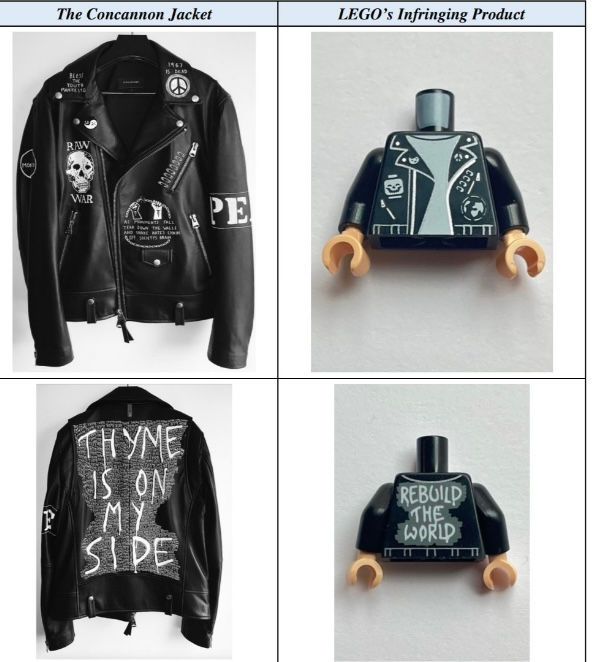LEGO, a Leather Jacket and Copyright Infringement
- Ariel Lola
- Dec 28, 2022
- 3 min read
REPOSTED FROM THE ARCHIVE
LEGO is building a copyright controversy over a leather style jacket on a LEGO figure in its Queer Eye set: “The Fab 5 Loft”. In December, artist James Concannon filed a copyright infringement lawsuit arguing that LEGO intentionally copied a custom leather jacket he created for the Queer Eye star Antoni Porowski without permission.

Image from the case document.
Facts
Concannon states that he never approved the use of the leather jacket on Queer Eye. However, LEGO claims that gifting the custom leather jacket in 2018 to Porowski granted an ‘implied license’ to Netflix for any use of the jacket including sub-licensing use to LEGO. On Queer Eye, Porowski wore numerous garments with Concannon’s artwork. Concannon argues that each time these garments were on the show he received an email to approve the uses, except for the leather jacket. Therefore, he claims that Netflix never had a license to show the jacket on the show. While approving uses of items on shows seems like good proactive, there are questions around if this is necessary. Regardless, Concannon states he did not and would not give permission for LEGO to recreate his artwork in connection to Queer Eye for free.

Images of Concannon's "propaganda-inspired aesthetic" from the case document.
Copyright
According to Mike Dunford, a lawyer and intellectual property researcher, the legal issue in this case will be whether LEGO’s infringing product is substantially similar in design to the Concannon jacket. However, this question does not consider the physical leather jacket as part of the infringement. All clothing has been ruled as functional no matter how fancy, so unable to receive copyright protection. Therefore, only separable elements from the clothing can qualify for protection. Physical separability is when an element, such as a sculptural clasp on a handbag, can be physically removed and be separate from the functional element. Conceptual separability is when designs, such as colour blocking, can be imagined as a design separate from the garment.
Dunford explains that this case relies on conceptual separability where what will be analyzed for substantial similarity is the arrangement of art on the jacket as a separate 2-dimensional design from the jacket. The U.S. Supreme Court in Star Athletica, LLC v. Varsity Brands, Inc held that an element of a useful article can qualify for copyright protection through a two-part test: 1) you can image it separately and 2) when it is considered separate it would qualify as protectable through copyright.
Susan Scafidi, the first professor to offer a formal U.S. law school fashion law course, explains conceptual separability in Star Athletica, LLC v. Varsity Brands, Inc through three images. Varsity copyrighted a series of designs on cheerleader uniforms and Star Athletica, a competitor, coped the designs. Scafidi states that there was confusion about arguing for copyright of a garment as opposed to the designs on a garment because the designs were shown edge-to-edge on a garment through images on people as opposed to edge-to-edge on a paper. So, imagine colour blocked paintings such as Mondrian in the 1920s, colour blocked dress in black white and primary colours by Yves Saint Laurent, and finally a 1980s Australian cheerleading team in Mondrian inspired cheerleading outfits. Scafidi states, “if you cut out part of the cheerleader uniform and mounted it on a canvas, you’ve got a Mondrian”; therefore, the designs on the uniform should be subject to copyright.
The comparison between the Conannon jacket and LEGO’s infringing product will rely on the unique arrangement and coordination of elements. However, it is worth noting that some elements such as the peace sign are not protectable because it is common.
It will be interesting to see how this case proceeds given the changes LEGO made to elements on the jacket. For example, the switch of the skull to a LEGO head in the same spot and the text on the back changed but remaining in the same script and style.




Comments